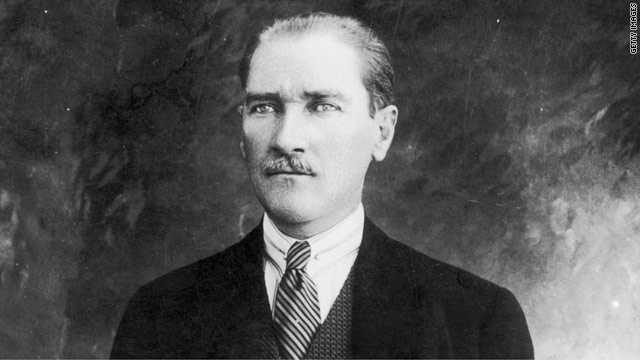Kemalism is dead, but not Ataturk
Editor’s Note: Soner Cagaptay is a senior fellow at the Washington Institute for Near East Policy and a GPS contributor. You can find all his blog posts here. The views expressed in this article are solely those of Soner Cagaptay.
By Soner Cagaptay – Special to CNN

Has Turkey’s twentieth century experience with Kemalism – a Europe-oriented top-down Westernization model – come to an end?
To a large extent: Yes.
Symbolically speaking, nothing could portend the coming end of Kemalism better than the recent public exoneration of Iskilipli Atif Hoca, a rare resistance figure to Kemalism in the early twentieth century. However, even if Kemalism might be withering away, ironically its founder Ataturk and his way of doing business seem to be alive in Turkey.
But first the story of Iskilipli Atif Hoca: In November 1925, Ataturk carried out perhaps the most symbolic of his reforms, banning all Turkish males from wearing the Ottoman fez in order to cement his country’s commitment to European ideals. Ataturk wanted make Turks European head to toe and the abolition of the fez embodied this effort.
Most Turks acquiesced to Ataturk’s reforms, not just to the “hat reform” but also to deeper ones such as the “alphabet reform,” which changed the Turks’ script from an Arab alphabet-based one to its current Latin-based form, further connecting the Turks to European culture.
Ataturk was able to achieve these reforms with minor resistance thanks to the weight of his persona. After all, Ataturk – who had just liberated Turkey from a massive Allied occupation – was considered nothing short of a father to all Turks.
Some Turks, however, objected to his reforms.
Enter Atif Hoca, a cleric in the small central Anatolian town of Iskilip, who refused to adhere to Ataturk’s “hat reform.” Atif Hoca defended his use of the fez, couching his objections in Islam. He rallied to protest against the reforms and began publishing essays in local papers. He was executed in February 1926, becoming a rare icon of resistance to Kemalism.
Recently though, Atif Hoca’s legacy has been reversed in the public eye. In February 2012, the government decided to name a public hospital in Iskilip – Atif Hoca’s hometown – after him. This dedication carries remarkable symbolic significance, as it is tantamount to honoring one of the best known anti-Kemalists to date, as well as signaling Turkey’s move to a post-Kemalist era.
Kemalism appears to have lost its influence, not just symbolically but also politically. In the past decade, Turkey has undergone a complete transformation. The ruling Justice and Development Party (AKP) has won three consecutive elections since 2002, with increasing majorities. The AKP, representing a brand of Islam-based social conservatism, has since replaced Turkey’s former Kemalist ideology and secular elites. Turkey seems to be moving to a post-Kemalist era.
Though, this is not to suggest that Ataturk is out, too. On the contrary, Ataturk shapes the Turkish mindset in the post-Kemalist Turkey. The legacy of Turkey’s liberator is too powerful to resist even if Turkey is seemingly “moving on” from his ideology.
Perhaps the most powerful aspect of Ataturk’s legacy is that he wanted to restore Turkey’s great power status. To this end, Ataturk envisaged stripping Turkey of its Ottoman legacy and instilling in it a set of European standards and beliefs so that Turkey could successfully compete against its historic European rivals. In other words, Turkey could become more powerful than Europe only by becoming entirely European itself.
Turkey’s new elites have a different view of how to make the country powerful, not by abandoning the country’s Ottoman past or secularizing its religious values, but by embracing them. Though, the ultimate goal remains the same: Become powerful enough to compete against the Europeans. Even if the post-Kemalist Turkey is not going to emulate Europe, it will still treat it as a measuring stick.
A second aspect of Ataturk’s legacy that remains alive in post-Kemalist Turkey is top-down social engineering. In the same way that Ataturk wanted to shape modern Turkey in his own image, his successors will now want to do the same, imposing their own worldview on Turkish society.
In this regard, Turkish Prime Minister Recep Tayyip Erdogan is a case-in-point. Like Ataturk, Erdogan seems willing to use the weight of his personality to remake Turkish society to match his worldview. Erdogan has already ruled Turkey longer than any other democratically-elected prime minister, and he might replace Ataturk as the country’s longest-reigning leader if he is elected as the president of Turkey in 2014. Like Ataturk, Erdogan seems willing to use his personal charisma to remake Turkish society to match his vision.
Ataturk often said “he wanted to raise contemporary European generations” among Turks. Recently, Erdogan said “he would like to raise religious generations” among the Turks. Kemalism may be dead, but Ataturk’s way of doing business appears to be alive and kicking in Turkey.
The views expressed in this article are solely those of Soner Cagaptay.
via Kemalism is dead, but not Ataturk – Global Public Square – CNN.com Blogs.

Leave a Reply